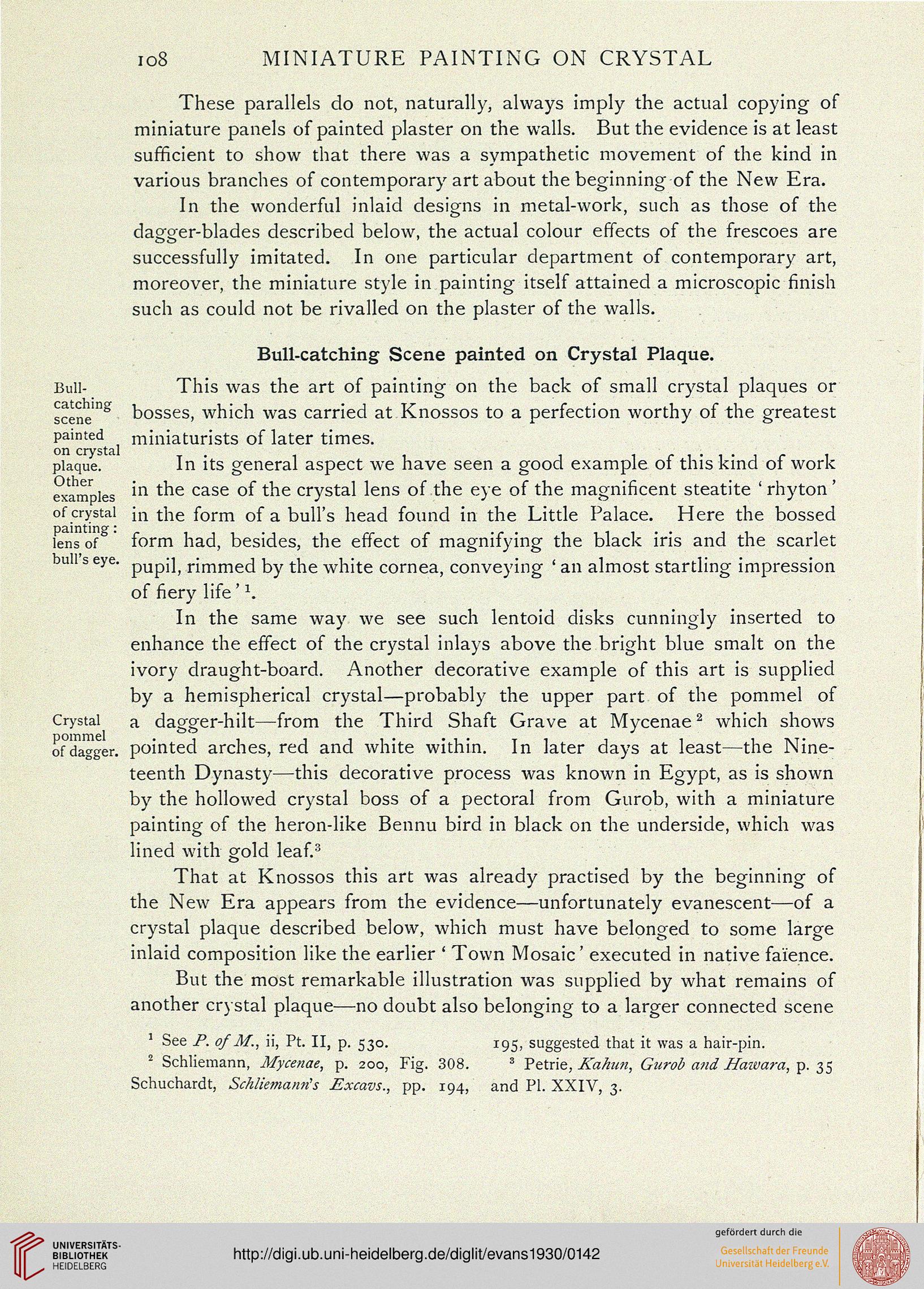108 MINIATURE PAINTING ON CRYSTAL
These parallels do not, naturally, always imply the actual copying of
miniature panels of painted plaster on the walls. But the evidence is at least
sufficient to show that there was a sympathetic movement of the kind in
various branches of contemporary art about the beginning of the New Era.
In the wonderful inlaid designs in metal-work, such as those of the
dagger-blades described below, the actual colour effects of the frescoes are
successfully imitated. In one particular department of contemporary art,
moreover, the miniature style in painting itself attained a microscopic finish
such as could not be rivalled on the plaster of the walls.
Bull-catching Scene painted on Crystal Plaque.
Bull- This was the art of painting on the back of small crystal plaques or
scene'ng bosses, which was carried at Knossos to a perfection worthy of the greatest
painted miniaturists of later times.
plaque. In its general aspect we have seen a good example of this kind of work
examples m t^le case °f ^e crystal lens of the eye of the magnificent steatite ' rhyton'
of crystal in the form of a bull's head found in the Little Palace. Here the bossed
lens of form had, besides, the effect of magnifying the black iris and the scarlet
bull s eye. pUpj]j rimmed by the white cornea, conveying ' an almost startling impression
of fiery life'x.
In the same way we see such lentoid disks cunningly inserted to
enhance the effect of the crystal inlays above the bright blue smalt on the
ivory draught-board. Another decorative example of this art is supplied
by a hemispherical crystal—probably the upper part of the pommel of
Crystal a dagger-hilt—from the Third Shaft Grave at Mycenae2 which shows
of dagger, pointed arches, red and white within. In later days at least—the Nine-
teenth Dynasty—this decorative process was known in Egypt, as is shown
by the hollowed crystal boss of a pectoral from Gurob, with a miniature
painting of the heron-like Bennu bird in black on the underside, which was
lined with gold leaf.3
That at Knossos this art was already practised by the beginning of
the New Era appears from the evidence—unfortunately evanescent—of a
crystal plaque described below, which must have belonged to some large
inlaid composition like the earlier ' Town Mosaic' executed in native faience.
But the most remarkable illustration was supplied by what remains of
another crystal plaque—no doubt also belonging to a larger connected scene
1 See P. of M., ii, Pt. II, p. 530. 195, suggested that it was a hair-pin.
2 Schliemann, Mycenae, p. 200, Fig. 308. 3 Petrie, Kahun, Gurob and Hawara,^. 35
Schuchardt, Schliemanris Excavs., pp. 194, and PI. XXIV, 3.
These parallels do not, naturally, always imply the actual copying of
miniature panels of painted plaster on the walls. But the evidence is at least
sufficient to show that there was a sympathetic movement of the kind in
various branches of contemporary art about the beginning of the New Era.
In the wonderful inlaid designs in metal-work, such as those of the
dagger-blades described below, the actual colour effects of the frescoes are
successfully imitated. In one particular department of contemporary art,
moreover, the miniature style in painting itself attained a microscopic finish
such as could not be rivalled on the plaster of the walls.
Bull-catching Scene painted on Crystal Plaque.
Bull- This was the art of painting on the back of small crystal plaques or
scene'ng bosses, which was carried at Knossos to a perfection worthy of the greatest
painted miniaturists of later times.
plaque. In its general aspect we have seen a good example of this kind of work
examples m t^le case °f ^e crystal lens of the eye of the magnificent steatite ' rhyton'
of crystal in the form of a bull's head found in the Little Palace. Here the bossed
lens of form had, besides, the effect of magnifying the black iris and the scarlet
bull s eye. pUpj]j rimmed by the white cornea, conveying ' an almost startling impression
of fiery life'x.
In the same way we see such lentoid disks cunningly inserted to
enhance the effect of the crystal inlays above the bright blue smalt on the
ivory draught-board. Another decorative example of this art is supplied
by a hemispherical crystal—probably the upper part of the pommel of
Crystal a dagger-hilt—from the Third Shaft Grave at Mycenae2 which shows
of dagger, pointed arches, red and white within. In later days at least—the Nine-
teenth Dynasty—this decorative process was known in Egypt, as is shown
by the hollowed crystal boss of a pectoral from Gurob, with a miniature
painting of the heron-like Bennu bird in black on the underside, which was
lined with gold leaf.3
That at Knossos this art was already practised by the beginning of
the New Era appears from the evidence—unfortunately evanescent—of a
crystal plaque described below, which must have belonged to some large
inlaid composition like the earlier ' Town Mosaic' executed in native faience.
But the most remarkable illustration was supplied by what remains of
another crystal plaque—no doubt also belonging to a larger connected scene
1 See P. of M., ii, Pt. II, p. 530. 195, suggested that it was a hair-pin.
2 Schliemann, Mycenae, p. 200, Fig. 308. 3 Petrie, Kahun, Gurob and Hawara,^. 35
Schuchardt, Schliemanris Excavs., pp. 194, and PI. XXIV, 3.




